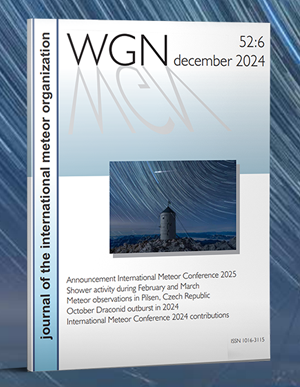No matter where you live, the first half of
December provides some of the best meteor activity of the year. In the northern
hemisphere the sporadic rates are still strong plus you can also count on strong
activity from the Geminids, which peak on December 13. There are also several
minor radiants that add a few meteors each hour. All of these centers of activity
are located high in the sky during the early morning hours this time of year.
Unfortunately this year the bright moon spoils the show during the first week of
the month. During the second week of December the moon will pass its last quarter
phase and will not be such a nuisance .
As seen from the southern hemisphere the sporadic
rates are increasing toward a January maximum. Shower rates are also good but the
Geminids suffer a bit from the lower elevation seen from southern locations. Still
with the warmer weather now occurring south of the equator, December is a great
time to view celestial fireworks.
During this period the moon reaches its new phase
on Wednesday December 16th. On that date the moon lies near the sun and cannot be
seen at night. This weekend the waning crescent moon will rise during the late
morning hours but will not cause any interference. The estimated total hourly rates
for evening observers this week is near five as seen from the northern hemisphere
and three from the southern hemisphere. For morning observers the estimated total
hourly rates should be near forty from the northern hemisphere and twenty as seen
from the southern hemisphere. The actual rates will also depend on factors such as
personal light and motion perception, local weather conditions, alertness and
experience in watching meteor activity.
The radiant positions and rates listed below are exact
for Saturday night/Sunday morning December 12/13. These positions do not change
greatly day to day so the listed coordinates may be used during this entire period.
Most star atlases (available at science stores and planetariums) will provide
maps with grid lines of the celestial coordinates so that you may find out exactly
where these positions are located in the sky. A planisphere or computer planetarium
program is also useful in showing the sky at any time of night on any date of the
year. Activity from each radiant is best seen when it is positioned highest in the
sky, either due north or south along the meridian, depending on your latitude. It
must be remembered that meteor activity is rarely seen at the radiant position.
Rather they shoot outwards from the radiant so it is best to center your field of
view so that the radiant lies at the edge and not the center. Viewing there will
allow you to easily trace the path of each meteor back to the radiant (if it is
a shower member) or in another direction if it is a sporadic. Meteor activity is
not seen from radiants that are located below the horizon. The positions below
are listed in a west to east manner in order of right ascension (celestial longitude).
The positions listed first are located further west therefore are accessible earlier
in the night while those listed further down the list rise later in the night.
The following showers are expected to be active this week:
Now that the activity from particles produced by comet 2P/Encke has ceased encountering
the Earth, the Taurid showers for 2009 are over and we resume reporting activity from
the Antihelion radiant. This is not a true radiant but rather activity caused
by the Earth’s motion through space. As the Earth revolves around the sun it encounters
particles orbiting in a pro-grade motion that are approaching their perihelion point.
They all appear to be radiating from an area near the opposition point of the sun,
hence the name Antihelion. These were once recorded as separate showers throughout the
year but it is now suggested to bin them into their category separate from true
showers and sporadics. This radiant is a very large oval some thirty degrees wide
by fifteen degrees high. Activity from this radiant can appear from more than one
constellation. The position listed here is for the center of the radiant which is
currently located at 06:16 (094) +23. This position lies in western Gemini near the
fourth magnitude star Eta Geminorum. Antihelion activity may also appear from eastern
Taurus, northeastern Orion, or southern Auriga. This radiant is best placed near
0100 local standard time (LST) when it lies on the meridian and is highest in the
sky. Rates at this time should be near three per hour as seen from the northern
hemisphere and two per hour from south of the equator. With an entry velocity of
30 km/sec., the average Antihelion meteor would be of slow speed.
The Monocerotids (MON) are active from a radiant located at 06:52 (103) +07.
This position lies in northwestern Monoceros halfway between the bright stars Betelgeuse
(Alpha Orionis) and Procyon (Alpha Canis Minoris). This shower peaked on December 8,
so activity is waning. Current rates would most likely average less than one per
hour no matter your location. The Monocerotids are best seen near 0100 LST when the
radiant lies highest above the horizon. At 41 km/sec. the Monocerotids
produce mostly meteors of medium velocity.
The Geminids (GEM) are active from a radiant located at 07:33 (113) +32.
This position lies in northern Gemini near the fourth magnitude star Rho Geminorum.
Although Geminid meteors can be seen all night long, they are best seen near 0200
LST when the radiant lies highest above the horizon. This shower is
expected to peak Sunday and Monday December 13/14 when rates can surpass 60 shower
members per hour as seen from dark sites. Geminid activity can be seen from the
southern hemisphere but at at much reduced rate. As seen from south of the equator,
Geminid activity could only be seen for a few hours before and after 0200 LST.
At 35 km/sec. the Geminids produce mostly meteors of medium velocity.
The Puppid-Velids (PUP) are a vast complex of weak radiants located in the
constellations of Puppis and Vela. Visual plots and photographic studies have
revealed many radiants in this area during November and December. The combined
strength of these radiants can produce a ZHR of ten. Actual hourly rates will be
much less unless you happen to be observing from the deep Southern Hemisphere.
The center of this activity is currently located at 08:26 (126) -45. This position
lies in western Vela, five degrees northeast of the second magnitude star Gamma
Velorum. Peak rates occurred near December 7 so current activity is waning. These
meteors are best seen near 0300 LST when the radiant lies highest above the horizon.
Observers located in the Southern Hemisphere have an advantage viewing this
shower as the radiant will rise higher into their sky allowing more activity to
be seen. At 40 km/sec. the Puppid-Velids produce meteors of medium velocity.
The Sigma Hydrids (HYD) are active from a radiant located at 08:42 (130) +01.
This position lies in western Hydra, just below the group of fourth magnitude stars
that make up the “head” of the water serpent. These meteors are best seen near 0300
LST when the radiant lies highest above the horizon. Current rates would be near
one per hour no matter your location. At 61 km/sec. the Sigma Hydrids produce mostly
swift meteors.
The December Leonis Minorids (DLM) are active from a radiant located at 10:22
(155) +34. This position lies in central Leo Minor, approximately ten degrees north
of the third magnitude star Zeta Leonis. These meteors are best seen near 0500
LST when the radiant lies highest above the horizon. This shower peaks on December
20th so current rates would be near one per hour as seen from the northern hemisphere
and less than one per hour as seen from south of the equator. At 64 km/sec. the
December Leonis Minorids produce mostly swift meteors.
Activity from the Coma Berenicids (COM) has just begun for 2009. The radiant
is located at 11:30 (173) +18. This position actually lies in eastern Leo, five degrees
northwest of the second magnitude star Denebola (Beta Leonis). These meteors are
best seen near 0600 LST when the radiant lies highest above the horizon. This shower
peaks on December 16th so current rates would be near one per hour no matter your
location. At 65 km/sec. the Coma Berenicids produce mostly swift meteors.
Lastly, the December Alpha Draconids (DAD) are active from a radiant located at
14:00 (210) +58. This position actually lies in northeastern Ursa Major, six degrees
northeast of the second magnitude double star Mizar (Zeta Ursae Majoris). These
meteors are best seen during the last dark hour before dawn, when the radiant lies
highest above the horizon in a dark sky. This shower is near the end of its activity
period so expected rates would be less than one no matter your location. At 44 km/sec.
the Alpha Draconids produce mostly medium speed meteors.
As seen from the mid-northern hemisphere (45N) one would expect to see approximately
sixteen Sporadic meteors per hour during the last hour before dawn as seen
from rural observing sites. Evening rates would be near three per hour. As seen from
the mid-southern hemisphere (45S), morning rates would be near ten per hour as seen
from rural observing sites and two per hour during the evening hours. Locations
between these two extremes would see activity between the listed figures.
The table below presents a condensed version of the expected activity this week.
Rates and positions are exact for Saturday night/Sunday morning but may be used
all week long.
| SHOWER | DATE OF MAXIMUM ACTIVITY | CELESTIAL POSITION | ENTRY VELOCITY | CULMINATION | HOURLY RATE | CLASS* | RA (RA in Deg.) DEC | Km/Sec | Local Standard Time | North-South | Antihelion (ANT) | – | 06:16 (094) +23 | 30 | 01:00 | 3 – 2 | II | Monocerotids (MON) | Dec 08 | 06:52 (103) +07 | 41 | 01:00 | <1 - <1 | II | Geminids (GEM) | Dec 13 | 07:33 (113) +32 | 35 | 02:00 | 60 – 20 | I | Puppid-Velids (PUP) | Dec 07 | 08:26 (126) -45 | 40 | 03:00 | <1 - 2 | II | Sigma Hydrids (HYD) | Dec 06 | 08:42 (130) +01 | 61 | 03:00 | 1 – 1 | II | December Leonis Minorids (DLE) | Dec 20 | 10:22 (155) +34 | 64 | 05:00 | 1 – <1 | II | Coma Berenicids (COM) | Dec 16 | 11:30 (173) +18 | 65 | 06:00 | 1 – 1 | II | December Alpha Draconids (DAD) | Dec 05 | 14:00 (210) +58 | 44 | 08:00 | <1 - <1 | IV |




 You saw something bright and fast? Like a huge shooting star? Report it: it may be a fireball.
You saw something bright and fast? Like a huge shooting star? Report it: it may be a fireball.  You counted meteors last night? Share your results with us!
You counted meteors last night? Share your results with us!  You took a photo of a meteor or fireball? You have a screenshot of your cam? Share it with us!
You took a photo of a meteor or fireball? You have a screenshot of your cam? Share it with us!  You caught a meteor or fireball on video? Share your video with us!
You caught a meteor or fireball on video? Share your video with us!